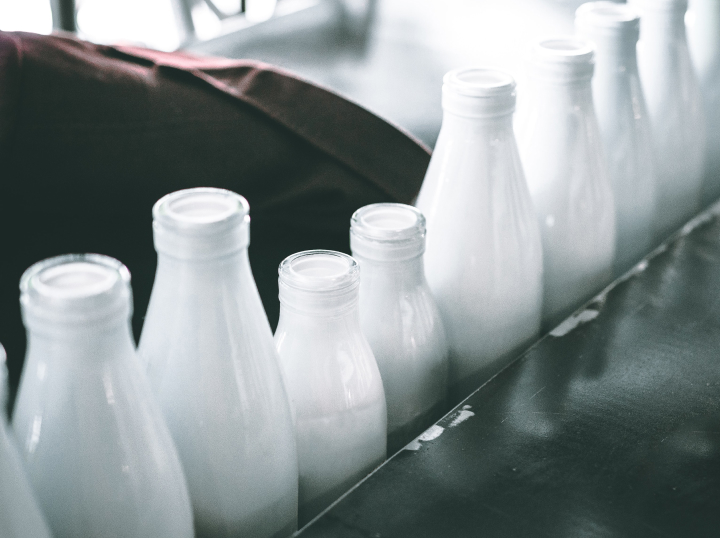Sustainable Agriculture
Milk’s role in sustainable agriculture
A dairy cow in a pasture feels like a long way from the milk in our refrigerators and at our tables. But the distance between the farm and your family is shorter and more sustainable than you might think. Dairy farmers are committed to sharing milk’s vital nutrients in more environmentally conscious ways by reducing the environmental impact of dairy farming. They’re making great strides today and with each generation.
Sometimes it might feel difficult to balance your family’s nutritional needs with a sustainable diet that’s best for the planet, but dairy milk production uses fewer resources than ever while providing a nutrient package like few other foods or beverages.
Compared with 75 years ago,[i] the production of one gallon of milk requires:
65 percent less water
90 percent less land
76 percent less manure
Those reductions translate into a 63 percent smaller carbon footprint of milk today than it did in 1944. The dairy industry wants to do even better and has committed to a goal of becoming carbon neutral or better by 2050, in yet another example of their commitment to sustainable agriculture.
In fact, U.S. dairy contributes just 2 percent[ii] of greenhouse gas emissions (GHGe), and accounts for 5.1 percent water withdrawal and 3.7 percent of U.S. farmland use. For comparison purposes, the largest contributor to GHGe in the U.S. is the transportation sector, which accounted for 28.5 percent of GHGe as of 2016.
Among the more than 40,000 dairy farms in the U.S., family farmers own and operate 94 percent of them. These farms range in size from just a couple dozen cows to more than 500, with the majority falling in the range of 50 to 99 cows. Many farms have been in families for generations, and farmers take their responsibility to be more efficient and make sustainable food seriously, because doing so is in the best interest of their cows and their livelihoods.
Farmers, who work the land and care for the animals that help nourish us, understand that resources are finite and must be handled wisely. From using sustainable cow feed to reusing water and repurposing manure for fertilizer, farmers improve their operating practices, reduce waste and contribute to a better environment for us today and our children and grandchildren in the future.
New Innovations Make a Difference to Reduce the Environmental Impact of Dairy Farming
Improved sustainability efforts are happening across the country. E-Z Acres in Homer, New York earned an Outstanding Dairy Farm Sustainability award for 2018. The owners, brothers Mike and Pete McMahon, have focused on local water quality for more than 20 years, managing fertilizers and reducing phosphorous use by 30%, which protects waterways and more in their community.
Royal Dairy, a 6,000-cow farm in Royal City, Washington, won an award for using millions of worms to help process manure. Worm-dense soil, wood shavings, and gravel filter the manure and help reduce odors and greenhouse gas emissions on the farm while creating the opportunity to recycle thousands of gallons of water on a daily basis. The U.S. Dairy Sustainability Awards, judged by an independent panel, honor innovative measures to improve the well-being of people, their animals and the planet.

A truly sustainable diet involves far more than its impact on our physical surroundings. It must also be nutrient-rich, practical and affordable. When you buy a gallon of milk, you’re supporting farmers committed to continuous improvement, doing their part to ensure a healthy planet for future generations, while at the same time getting one of the most nourishing foods available in an affordable, delicious package. Dairy milk is a natural source of high-quality protein and is the top food source for calcium and vitamin D, which our diets, especially children’s, are often lacking. In all, milk provides thirteen essential nutrients and is one of the original farm-to-table foods. So not only are you making smart decisions about nutrition when you choose milk, you’re also providing your family with an increasingly sustainable food.
The notion of using plant-based foods that may have lower greenhouse gas emissions to replace all animal foods would likely increase nutritional deficiencies among the populations, research shows.[iii], [iv] For example, substituting milk with non-dairy calcium sources like fortified soy milk and leafy greens can lead to gaps in other key nutrients like protein, vitamin D, phosphorus, riboflavin and vitamin B12.[v] A shift to only plant-based foods is not necessarily better for people because it could increase the intake of refined grains and sugars and reduce consumption of foods rich in protein and dense with nutrients.[vi]
Across many aspects of life, balance is key, and that is especially true in how and what we eat. The right amount of animal and plant foods can help create more sustainable diets for our bodies and our planet. Milk, with its unique nutrient package, nourishes your family like no other food, and the broader dairy community works closely to ensure they’re using the best practices, technology and tools to continuously reduce the environmental impact of dairy farming while producing a high-quality product for you and your family. Dairy milk helps kids grow up strong while dairy farmers work to protect the environment and make our planet more sustainable today and for generations to come.
[i] Capper JL, Cady RA, Bauman DE. The environmental impact of dairy production: 1944 compared with 2007. Journal of Animal Science. 2009;87(6):2160-2167.
[ii] Henderson A, et al. (2012). U.S. Fluid Milk Comprehensive LCA. University of Michigan & University of Arkansas.
[iii] Cifelli CJ, Houchins JA, Demmer E, Fulgoni CL. Increasing plant based foods or dairy foods differentially affects nutrient intakes: dietary scenarios using NHANES 2007-2010. Nutrients. 2016; 8(7): 422.
[iv] White RR, Hall MB. Nutritional and greenhouse gas impacts of removing animals from US agriculture. Proceedings of the National Academy of Sciences of the United States of America. 2017; 114(48): e10301-e10308.
[v] Fulgoni VL, Keast DR, Auestad N, Quann EE. Nutrients from dairy foods are difficult to replace in diets of Americans: food pattern modeling and an analysis of the National Health and Nutrition Examination Survey 2003-2006. Nutrition Research. 2011;31:759-765.
[vi] Payne CL, Scarborough P, Cobiac L. Do low-carbon-emission diets lead to higher nutritional quality and positive health outcomes? A systematic review of the literature. Public Health Nutrition. 2016, 1–8.




